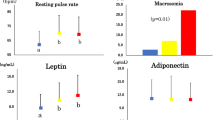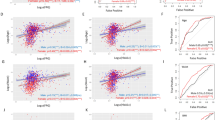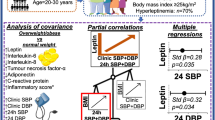Abstract
Objective:
To determine if levels of the adipocyte-derived hormone, leptin, predict the development of type 2 diabetes.
Methods:
Population-based surveys were undertaken in the multiethnic nation of Mauritius in 1987, 1992 and 1998. Questionnaires, anthropometric measurements, and a 2-h 75-g oral glucose tolerance test were included. A cohort of 2330 participants who were free of diabetes, aged 25–79 years in 1987, and who were followed-up in 1992 and 1998 was studied. Serum leptin was measured in baseline samples. Glucose tolerance was classified according to WHO (World Health Organization) 1999 criteria.
Results:
In total, 456 subjects developed diabetes over 11 years with similar incidences in all ethnic groups (P=0.2). Baseline leptin correlated positively with anthropometric measurements, fasting and postload insulin and homeostasis model assessment indices (all P<0.001), and inversely with subsequent weight increase. Participants with incident diabetes had higher serum levels of leptin at baseline than those remaining nondiabetic (P<0.001). After adjustment for confounders, high leptin levels and high leptin/body mass index ratio were independently associated with incident diabetes over 11 years in men (odds ratio for top versus bottom quartile of leptin 2.18; 95% CI: 1.09–4.35), but not in women.
Conclusion:
We conclude that high leptin levels are associated with the future development of diabetes, and the association is independent of other factors in men, but not in women.
This is a preview of subscription content, access via your institution
Access options
Subscribe to this journal
Receive 12 print issues and online access
$259.00 per year
only $21.58 per issue
Buy this article
- Purchase on Springer Link
- Instant access to full article PDF
Prices may be subject to local taxes which are calculated during checkout
Similar content being viewed by others
References
Ferrannini E, Camastra S . Relationship between impaired glucose tolerance, non-insulin dependent diabetes mellitus and obesity. Eur J Clin Invest 1998; 28: 3–7.
Boyko EJ, de Courten M, Zimmet PZ, Chitson P, Tuomilehto J, Alberti KG . Features of the metabolic syndrome predict higher risk of diabetes and impaired glucose tolerance: a prospective study in Mauritius. Diabetes Care 2000; 23: 1242–1248.
Margetic S, Gazzola C, Pegg GG, Hill RA . Leptin: a review of its peripheral actions and interactions. Int J Obes Relat Metab Disord 2002; 26: 1407–1433.
Trujillo ME, Scherer PE . Adiponectin – journey from an adipocyte secretory protein to biomarker of the metabolic syndrome. J Intern Med 2005; 257: 167–175.
Ouchi N, Kihara S, Funahashi T, Matsuzawa Y, Walsh K . Obesity, adiponectin and vascular inflammatory disease. Curr Opin Lipidol 2003; 14: 561–566.
Sader S, Nian M, Liu P . Leptin: a novel link between obesity, diabetes, cardiovascular risk, and ventricular hypertrophy. Circulation 2003; 108: 644–646.
Hynes GR, Jones PJ . Leptin and its role in lipid metabolism. Curr Opin Lipidol 2001; 12: 321–327.
Yamauchi T, Kamon J, Minokoshi Y, Ito Y, Waki H, Uchida S et al. Adiponectin stimulates glucose utilization and fatty acid oxidation by activating AMP-activated protein kinase. Nat Med 2002; 8: 1288–1295.
Ahima RS, Osei SY . Leptin signaling. Physiol Behav 2004; 81: 223–241.
O'Rahilly S, Farooqi IS, Yeo GS, Challis BG . Minireview: human obesity-lessons from monogenic disorders. Endocrinology 2003; 144: 3757–3764.
Kieffer TJ, Habener JF . The adipoinsular axis: effects of leptin on pancreatic beta-cells. Am J Physiol Endocrinol Metab 2000; 278: E1–E14.
McNeely MJ, Boyko EJ, Weigle DS, Shofer JB, Chessler SD, Leonnetti DL et al. Association between baseline plasma leptin levels and subsequent development of diabetes in Japanese Americans. Diabetes Care 1999; 22: 65–70.
Söderberg S, Stegmayr B, Stenlund H, Sjöström LG, gren A, Ågren A et al. Leptin, but not adiponectin, predicts stroke in males. J Intern Med 2004; 256: 128–136.
Seufert J . Leptin effects on pancreatic beta-cell gene expression and function. Diabetes 2004; 53: S152–S158.
Okuya S, Tanabe K, Tanizawa Y, Oka Y . Leptin increases the viability of isolated rat pancreatic islets by suppressing apoptosis. Endocrinology 2001; 142: 4827–4830.
Matarese G, Sanna V, Lechler RI, Sarvetnick N, Fontana S, Zappacosta S et al. Leptin accelerates autoimmune diabetes in female NOD mice. Diabetes 2002; 51: 1356–1361.
Central Intelligence Agency (CIA). Washington DC, USA. The world factbook 2006. https://www.cia.gov/cia/publications/factbook/index.html Last accessed: 21 December 2006.
Dowse GK, Collins VR, Alberti KG, Zimmet PZ, Tuomilehto J, Chitson P et al. Insulin and blood pressure levels are not independently related in Mauritians of Asian Indian, Creole or Chinese origin. The Mauritius Non-communicable Disease Study Group. J Hypertens 1993; 11: 297–307.
Dowse GK, Gareeboo H, Alberti KG, Zimmet P, Tuomilehto J, Purran A et al. Changes in population cholesterol concentrations and other cardiovascular risk factor levels after five years of the non-communicable disease intervention programme in Mauritius. Mauritius Non-communicable Disease Study Group. BMJ 1995; 311: 1255–1259.
Dowse GK, Gareeboo H, Zimmet PZ, Alberti KG, Tuomilehto J, Fareed D et al. High prevalence of NIDDM and impaired glucose tolerance in Indian, Creole, and Chinese Mauritians. Mauritius Noncommunicable Disease Study Group. Diabetes 1990; 39: 390–396.
Dowse GK, Zimmet PZ, Gareeboo H, George K, Alberti MM, Tuomilehto J et al. Abdominal obesity and physical inactivity as risk factors for NIDDM and impaired glucose tolerance in Indian, Creole, and Chinese Mauritians. Diabetes Care 1991; 14: 271–282.
Söderberg S, Zimmet P, Tuomilehto J, de Courten M, Dowse GK, Chitson P et al. Increasing prevalence of Type 2 diabetes mellitus in all ethnic groups in Mauritius. Diabet Med 2005; 22: 61–68.
Söderberg S, Zimmet P, Tuomilehto J, de Courten M, Dowse GK, Chitson P et al. High incidence of type 2 diabetes and increasing conversion rates from impaired fasting glucose and impaired glucose tolerance to diabetes in Mauritius. J Intern Med 2004; 256: 37–47.
World Health Organization-International Society of Hypertension Guidelines for the Management of Hypertension. Guidelines Subcommittee. J Hypertens 1999; 17: 151–183.
World Health Organization. Definition, diagnosis and classification of diabetes mellitus and its complications: Report of a WHO Consultation. Part 1. Diagnosis and classification of diabetes mellitus. World Health Organization: Geneva, 1999.
Soeldner JS, Slone D . Critical variables in the radioimmunoassay of serum insulin using the double antibody technic. Diabetes 1965; 14: 771–779.
Levy JC, Matthews DR, Hermans MP . Correct homeostasis model assessment (HOMA) evaluation uses the computer program. Diabetes Care 1998; 21: 2191–2192.
Haffner SM, Stern MP, Miettinen H, Wei M, Gingerich RL . Leptin concentrations in diabetic and nondiabetic Mexican-Americans. Diabetes 1996; 45: 822–824.
Clement K, Lahlou N, Ruiz J, Hager J, Bougneres P, Basdevant A et al. Association of poorly controlled diabetes with low serum leptin in morbid obesity. Int J Obes Relat Metab Disord 1997; 21: 556–561.
Hanaki K, Becker DJ, Arslanian SA . Leptin before and after insulin therapy in children with new-onset type 1 diabetes. J Clin Endocrinol Metab 1999; 84: 1524–1526.
Faust IM, Johnson PR, Hirsch J . Surgical removal of adipose tissue alters feeding behavior and the development of obesity in rats. Science 1977; 197: 393–396.
Schneider BS, Faust IM, Hemmes R, Hirsch J . Effects of altered adipose tissue morphology on plasma insulin levels in the rat. Am J Physiol 1981; 240: E358–E362.
Vickers MH, Reddy S, Ikenasio BA, Breier BH . Dysregulation of the adipoinsular axis – a mechanism for the pathogenesis of hyperleptinemia and adipogenic diabetes induced by fetal programming. J Endocrinol 2001; 170: 323–332.
Eisner JR, Dumesic DA, Kemnitz JW, Abbott DH . Timing of prenatal androgen excess determines differential impairment in insulin secretion and action in adult female rhesus monkeys. J Clin Endocrinol Metab 2000; 85: 1206–1210.
Zhou YT, Shimabukuro M, Lee Y, Koyama K, Trieu F, Unger RH . Leptin normalizes the impaired response of proinsulin mRNA to long chain fatty acids in heterozygous Zucker diabetic fatty rats. J Biol Chem 1997; 272: 25648–25651.
Khan A, Narangoda S, Ahren B, Holm C, Sundler F, Efendic S . Long-term leptin treatment of ob/ob mice improves glucose-induced insulin secretion. Int J Obes Relat Metab Disord 2001; 25: 816–821.
Unger RH, Zhou YT, Orci L . Regulation of fatty acid homeostasis in cells: novel role of leptin. Proc Natl Acad Sci USA 1999; 96: 2327–2332.
McGarry JD . Banting lecture 2001: dysregulation of fatty acid metabolism in the etiology of type 2 diabetes. Diabetes 2002; 51: 7–18.
Söderberg S, Ahrén B, Eliasson M, Dinesen B, Olsson T . The association between leptin and proinsulin is lost with central obesity. J Intern Med 2002; 252: 140–148.
Frühbeck G . Pivotal role of nitric oxide in the control of blood pressure after leptin administration. Diabetes 1999; 48: 903–908.
La Cava A, Alviggi C, Matarese G . Unraveling the multiple roles of leptin in inflammation and autoimmunity. J Mol Med 2004; 82: 4–11.
Clegg DJ, Riedy CA, Smith KA, Benoit SC, Woods SC . Differential sensitivity to central leptin and insulin in male and female rats. Diabetes 2003; 52: 682–687.
Meli R, Pacilio M, Raso GM, Esposito E, Coppola A, Nasti A et al. Estrogen and raloxifene modulate leptin and its receptor in hypothalamus and adipose tissue from ovariectomized rats. Endocrinology 2004; 145: 3115–3121.
Rocha M, Bing C, Williams G, Puerta M . Physiologic estradiol levels enhance hypothalamic expression of the long form of the leptin receptor in intact rats. J Nutr Biochem 2004; 15: 328–334.
Wallace AM, McMahon AD, Packard CJ, Kelly A, Shepherd J, Gaw A et al. Plasma leptin and the risk of cardiovascular disease in the west of Scotland coronary prevention study (WOSCOPS). Circulation 2001; 104: 3052–3056.
Acknowledgements
This study was undertaken with the support and collaboration of the Ministry of Health (Mauritius), the World Health Organization (Geneva, Switzerland), International Diabetes Institute (Melbourne, Australia), the University of Newcastle upon Tyne (UK), and the National Public Health Institute (Helsinki, Finland). This study was partially funded by US National Institutes of Health Grant DK–25446. We are grateful to Hans Stenlund, Department of Public Health and Clinical Medicine, Epidemiology, Umeå University, Sweden, for assistance in statistical matters. Dr Söderberg is supported by grants from the Swedish Heart and Lung Foundation and the Swedish Society of Medicine.
Author information
Authors and Affiliations
Corresponding author
Rights and permissions
About this article
Cite this article
Söderberg, S., Zimmet, P., Tuomilehto, J. et al. Leptin predicts the development of diabetes in Mauritian men, but not women: a population–based study. Int J Obes 31, 1126–1133 (2007). https://doi.org/10.1038/sj.ijo.0803561
Received:
Revised:
Accepted:
Published:
Issue Date:
DOI: https://doi.org/10.1038/sj.ijo.0803561
Keywords
This article is cited by
-
Attenuation of carbohydrate metabolism and lipid profile by methanolic extract of Euphorbia helioscopia and improvement of beta cell function in a type 2 diabetic rat model
BMC Complementary Medicine and Therapies (2022)
-
Leptins: association and clinical correlation in pre-diabetics
International Journal of Diabetes in Developing Countries (2022)
-
Associations of leptin and adiponectin with incident type 2 diabetes and interactions among African Americans: the Jackson heart study
BMC Endocrine Disorders (2020)
-
South Asian Cardiovascular Disease & Cancer Risk: Genetics & Pathophysiology
Journal of Community Health (2018)
-
Leptin levels after subarachnoid haemorrhage are gender dependent
SpringerPlus (2016)



